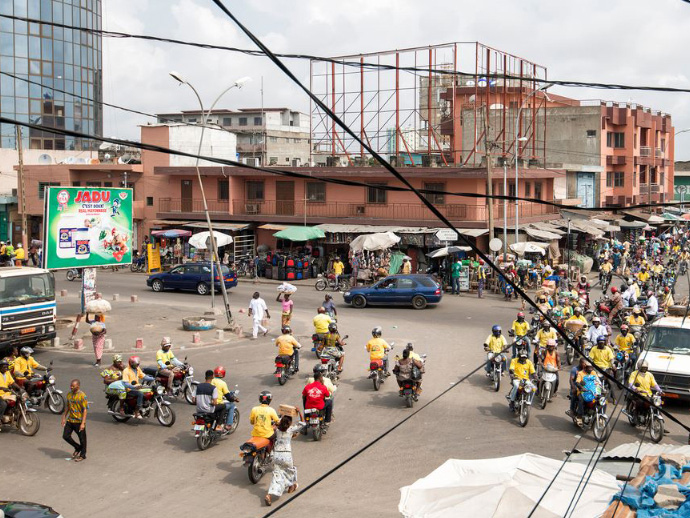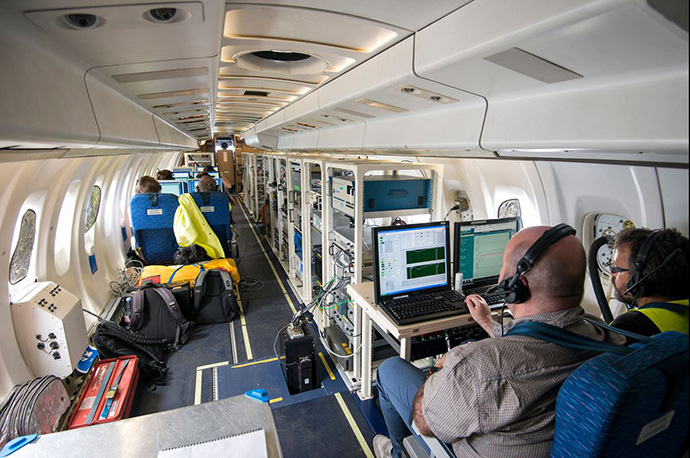

Angela Benedetti, ECMWF Atmospheric Composition Team and Peter Knippertz, Karlsruhe Institute of Technology, Institute of Meteorology and Climate Research (KIT IMK)
ECMWF was one of 16 partners in the EU-funded DACCIWA project co-ordinated by the Karlsruhe Institute of Technology (KIT) that finished at the end of 2018.
DACCIWA stands for “Dynamics-aerosol-chemistry-cloud interactions in West Africa”. As part of the project, we helped to collect new data in West Africa to investigate the causes and effects of air pollution, examining for the first time the entire chain of natural and human-made emissions, from formation and distribution to the impacts.
The results will contribute towards providing more accurate climate, weather and health forecasts to enable more sustainable development policies.
The problem

Traffic, waste combustion, domestic fires and dust from the Sahara pollute the air over African cities – with significant health implications. (Photo: Sébastien Chastanet)
Explosive population growth, urbanization and a growing economy have put the environment in West Africa under a lot of stress. The World Health Organization (WHO) estimates that each year, around seven million people die from the effects of polluted air. Each time people breathe in, they inhale an average of 500 ml of air. A healthy adult at rest takes about 8 million breaths per year, hence inhaling 4 million litres of air. Children inhale more air than adults do, relative to body surface area, breathing frequency, and heart rate.
Around 21% of the air people breathe is oxygen, 78% is nitrogen. There are also tiny amounts of other gases called trace gases, some of which are poisonous like carbon monoxide. There is also what is called particulate matter, sub-micron particles of various species and composition which can travel undisturbed to the lungs and cause a series of problems such as respiratory, cardiovascular and skin diseases.
In West African cities, the concentrations of small particles are often a lot higher than the WHO recommended limits. Some particles have their origin in human activities: charcoal fires, waste combustion in cities, and savanna fires which emit fine particles into the air. Other particles are of natural origin, for example wind-blown dust from the Sahara Desert.
Investigating causes and impacts
The European-African consortium DACCIWA was coordinated by the KIT. ECMWF’s role was to provide forecast data and conduct observation impact experiments and long-range simulations of the West-African environment.
DACCIWA collected new data to investigate the causes and effects of air pollution by examining the entire chain of natural as well as human-made emissions for the first time, from formation and distribution to the impacts. DACCIWA scientists also examined the interaction of air composition and the summer monsoon.
The research team published a policy brief that presents the most important results, campaigns and outlooks and provides concrete recommendations for action.
The DACCIWA observational campaign
Collecting comprehensive data was the biggest challenge. Since there was no adequate air quality monitoring system in South West Africa, numerical models could not reliably map the complex atmospheric dynamics and chemistry in West Africa.
Therefore, our team had to gather up-to-date data on the composition of the atmosphere, clouds and air, as well as information on health risks and diseases.

In flight and field surveys, the scientists examined the development and distribution of particulate matter over West Africa. (Photo: Sébastien Chastanet)
DACCIWA scientists evaluated data collected in West Africa by coordinated measuring flights with three research aircrafts of the German Aerospace Center (DLR), the French institutions CNRS, Météo-France and CNES, and the British Antarctic Survey.
On board, the different aircrafts had similar measuring instruments to collect a maximum of reference data. To capture urban emissions, we set up four measurement sites in Abidjan and Cotonou and evaluated health data.
In addition, researchers from the IMK recorded a multitude of relevant meteorological parameters with the atmospheric observation system “KITcube” in the Beninese Savè. At the same time, a KIT research group coordinated a large-scale meteorological balloon campaign in four West African countries.

Using meteorological balloons and the atmospheric observation system “KITcube”, the DACCIWA researchers collected a variety of relevant meteorological data. (Photo: Sébastien Chastanet)
For the planning of research flights and ground-based observations during the main campaign in June–July 2016, weather forecasts tailored to the needs of DACCIWA researchers were key.
We used a dedicated web page to provide a wide range of forecast products from different models and forecast centres, including ECMWF and the UK Met Office. After the campaign, we carefully evaluated the forecasts with the data collected during the campaign and those from conventional platforms (such as surface stations and satellites).

Example of a forecast plot used during the DACCIWA field campaign in June–July 2016. Shown is a 42-hour prediction from ECMWF of winds and humidity at about 3 km above ground.
Findings from DACCIWA
The results show that air pollution has already reached a health-damaging level.
During the dry season, the concentration of fine particles in the atmosphere is at its highest, as desert dust from the Sahara and smoke from fires in the savannah are mixed in the air in addition to the fine dust and anthropogenic particulate matter that originate in cities.
During the summer monsoon season, particulate matter from Central Africa, which can be transported thousands of kilometres by the prevailing southerly wind, appears in addition to local emissions. During the field surveys, 20 to 40 percent of the total particle counts over land were already detected above the ocean, indicating long-range transport.
Due to the high humidity during the wet summer monsoon, the particles can absorb more water, which makes them more opaque and implies that less sunlight reaches the ground. This in turn influences air circulation, cloud formation and precipitation probability. If pollution continues to increase, a possible reduction of rainfall may eventually affect food production, water and electricity.
Climate simulations by the DACCIWA project team indicate that temperatures in West Africa are expected to increase by one to three degrees Celsius by 2050, depending on geographic location. In addition, the increased particle concentration in southern West African cities can entail significant risks to public health and increase respiratory, cardiovascular and skin diseases.
For the first time, DACCIWA research has shown that the number of hospital visits due to these health problems is closely related to the concentration of particulate matter in the air. Especially during the rainy season, the number of known cases of illness increased, which may suggest that humidity amplifies the effects of air pollution on humans.
With the new data and analyses, scientists can provide more accurate climate, weather and health forecasts, not only for West Africa, but also for regions further away. For example, we know that the West African monsoon can affect European weather and is an important factor for Atlantic hurricanes. DACCIWA thus lays the foundations for more precise climate, weather and air quality models, which enable a more sustainable development policy.
At the end of DACCIWA, our consortium briefed politicians from Togo, Benin, Ghana and Côte d'Ivoire at meetings in Africa about our findings and recommended possible actions. We also presented and discussed the project results at the European Union in Brussels.
The DACCIWA project has received funding from the European Union Seventh Framework Programme (FP7/2007-2013) under grant agreement no. 603502. The consortium comprised 16 scientific institutions in Europe and Africa.
Top banner image: Sébastien Chastanet
